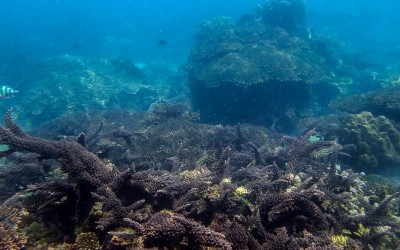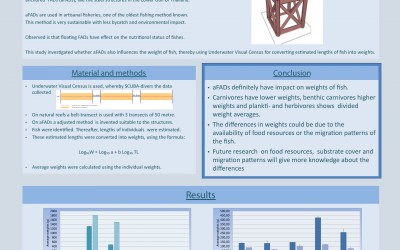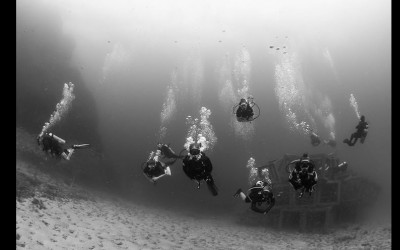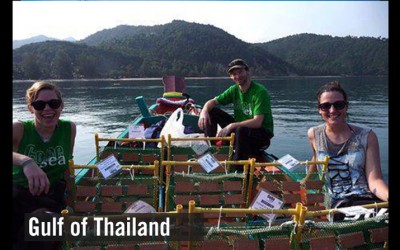Question: What do you get when you mix gorgeous beaches, sprawling resorts, overpriced seafood, fruity alcohol, and brightly flowered shirts?
Answer: The ideal all-American Hawaiian vacation.
To be honest, I’m one of those very few people who never quite grasped our country’s obsession with the archipelago of islands that makes up our 50th state.
Don’t get me wrong, I love the island life—I spent more time than planned on my five-month adventure to Thailand in Spring of 2014 exploring the reefs of Koh Phangan. But something about Hawaii has always felt contrived. Every experience is staged. What is there to do, really, besides lie around on beaches all day and snorkel and inevitably get sunburned? I don’t like lying around. I like exploring and pushing my limits. I always like to be moving. But our winter trip to Hawaii was different this time, because now I know how to dive. And diving is the epitome of adventure.
Diving is something I love to do, and not something I get to do a lot. So the first thing I did when we settled into the swanky resort hosting our 2014 family reunion, was call a dive shop on the southern end of Kauai and set up two dives for myself and my other dive-savvy cousin for the next afternoon.
I’d never been diving in U.S. customary units before—I learned to dive in metric. So my first few minutes were spent trying to understand why the numbers on my pressure gauge had so many zeros after them, before I realized that it was written in PSI not bar.
Our little dive speedboat bounced happily over the gentle waves of the Pacific Ocean. When we finally slowed and dropped anchor, I was the first one with my fins and mask on, ready to go. I buddy-checked my cousin, and then took a giant step into thin air off the side of the boat, cleanly breaking the surface of the sea. I felt the familiar rush of tepid water sneaking into all the open spaces in my wetsuit. I welcomed it. I smiled so big water crept into my regulator. The visibility was flawless, and far below us I could see the coral-strewn landscape of the ocean floor.
Our dive guide was a very enthusiastic woman named Diana* who doubled as a schoolteacher. She knew all about the different kinds of fish, and had pointed out species we might see using a laminated card on the boat ride over. She’d also told us we might see turtles, maybe even sharks. She’d gushed about how great the corals were where we were going.
We descended to the sandy bottom, and then set off in our little group of five, following Diana. I looked around for the vibrant fish, and the great corals she’d talked about.
But the corals weren’t great. Most of them were half dead, and the rest were bleaching. I saw maybe four patches of healthy coral in the entirety of that first 50-minute dive. Pale, butter yellows and pastel lavender colored most of the colonies. As we rounded a corner, long ropes of soft coral extended out like lengthy, skeletal fingers. I watched as Diana reached out with her ungloved hands and touched the coral lightly, motioning to us to do the same. My eyes widened. I was taught never to touch corals…or anything, for that matter.
I guess I just assumed that’s how everyone was taught to dive. Don’t touch anything. Keep your fins off the reef. But, as our dive time reached half an hour, I realized how wrong I was.
Diana kicked over to a gathering of dead branching corals, and motioned to us to join her, her eyes excited from behind her dive mask. She reached down and picked up the coral head with one hand, and with the other grabbed something that had been hiding underneath. She dropped the coral head quickly so she could use her other hand to restrain it against her chest. It was a small orange octopus. Its eight, boneless limbs shot out in every direction, struggling to escape. I could feel its panic. I looked in horror at Diana, who was completely oblivious. If we’d been above water, I probably would have yelled at her. But underwater, I couldn’t even get her attention to tell her to let go.
And did I even have the right to? I was a paying customer. I’m an Advanced Open Water diver. She was an instructor. She had hundreds of dives on me. I didn’t want to be the sassy know-it-all trying to shove my way of diving on someone else. But I couldn’t bear to look at the octopus. So I looked away, behind me. That’s when I saw the sea turtle.
She was huge. Easily as big as I was. She glided over our heads. Diana let go of the octopus, which scooted away in relief. The turtle settled in the sand about 10 feet from us, and propelled her front and back flippers, stirring up the sand so it fell over her back.
Diana swam over. Apprehensively, I followed with the other three divers in our group. I watched Diana let the air out of her BCD so her body would gently settle on the ocean floor. It was all sand around us, so I did the same. We hung out there with the turtle for a few minutes, just watching her. Diana got our attention by waving her flashlight in our faces, and pointed at the turtle before placing her palms together, closing her eyes, and resting her cheek on her hands, telling us the turtle was sleeping. Then, she reached out and stroked the turtle’s back flipper with one finger.
The turtle jolted, and looked around. Seeing she was surrounded, she kicked off from the seafloor, sending a cascade of sand down from her shell, and swam lazily away in search of a more restful place to take a nap.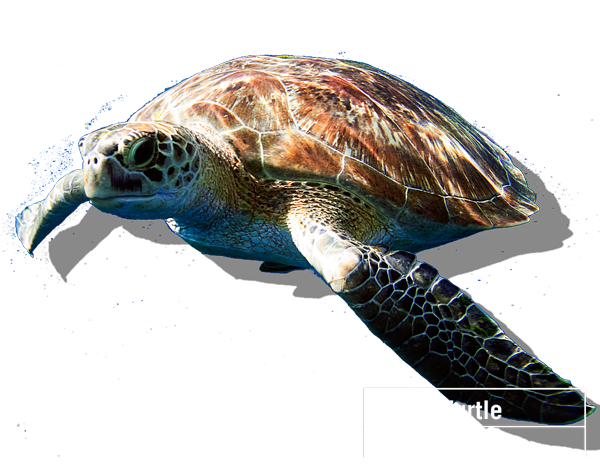
Back on the dive boat, I steamed silently to myself. Diana came over to brief us on our second dive of the afternoon. She sat down heavily and smiled at us.
“Amazing, huh?” She enthused. “Gale, are you having fun?” She called over her shoulder to my seasick cousin, who was hanging limply halfway over the side of the boat. “Poor kid.” She shook her head. Then her face became serious. As we sped to our next site, she told us about how much trouble the ocean was in. “That octopus we saw, the turtle we saw, that coral you got to touch with your own hands…it’s all going to be gone if we don’t do something,” she explained to us. “All those beautiful purple and pink corals—gone. We’ve got a real problem with rising ocean temperatures, it’s really hard on the coral…”
As she went on about ocean conservation, I realized Diana cares about the sea and the creatures in it just as much as I do. In fact, she’s dedicated half her work life to showing tourists the wonders of the Hawaiian coral reefs. It’s not just because diving is fun for her. Pulling an octopus out from its hiding place, or disrupting a sleeping sea turtle so we can watch it swim away…it’s not because she’s a cruel person. She wants to make the dive memorable and special, so people will get more out of it than just a good time—she wants to make people care as much as she does. Nobody has told her how much damage she’s doing when she touches corals or kicks off the reef.
That is the point of this story: When I learned to dive, it was so I could participate in a program where I was trained to be a Tropical Conservation Diver. Before I was even allowed to dive on a reef, I had to practice a trim position where my knees were bent and my feet were in the air so my fins wouldn’t bump any corals. I took data on places where human impact had ruined entire coral colonies. I did all of this because I care about the ocean. The truth is, once you learn to dive, it’s impossible not to care. The undersea world is unlike any other. Cathedrals of corals house finned citizens so beautiful you sometimes forget to breathe. When you roll over on your back and look back up at the surface, you see a burst of shimmering silver from the sun reflecting through the water. There are moments when your buoyancy is perfect and you feel like you’re in zero gravity, floating there just like the turtle next to you. You feel like you belong here, too. Like the ocean is your home, despite the huge out-of-place tank strapped to your back.
The key to ocean conservation is to make more people care about the ocean, and I think the best way to do that is by teaching people to literally get their feet wet. But there’s a price—the more divers we have who don’t realize their impact, the harder it is to protect the places we’re teaching them to care about. Humans have the power to be hugely destructive, but we also have the power to make a positive change. The key is educating divers worldwide to properly respect the reefs and all the creatures that make their homes there.
*Names have been changed.
Buy cool Apparel
Support us, buy cool stuff
Join the team
make a difference
Learn more
About the Oceans

Lina Bell
Author
Lina studies sustainable food & farming and photography, at the Evergreen State College, Washington State. Her humorous writing style and great photography impressed us quite a bit when she joined us for an internship, so we begged her to keep writing. She did.
Browse other Articles
Simulation of overfishing and eutrophication
The biggest factors threatening coral reefs today are considered to be overfishing and high nutrient levels from untreated sewage. Ines simulated that by adding fertilizer, and excluding herbivore fish with a nifty cage design. See the...
Influence of aFADs on the weight of fishes
Artificial Reefs are man-made structures replicating the properties of natural features. They are used to restore coral reefs, but they are also known for their fish aggregating behavior. This feature makes them an important tool to...
Coastal Zone Management
The coastal zone is a very dynamic place, because it is influenced by so many different factors. Like, waves, tides, currents, river discharge, changing sea levels, sinking and rising of the land and of course those pesky humans you see...
Sunken Treasure
Reproduced with permission from Author. Originally published on custommade.com Underwater Timber Stands the Test of Time When people think of timber harvest, Paul Bunyon in SCUBA gear is not the first image that comes to mind....
The catch-22 of Sea Food: Ghost Nets
Sea food tastes great, but it leaves people like Rebecca Lehmann with quite a mess to clean up. Read her article on a ghost net removal below. It was an early 7 AM start as we head out to Samran Pinnacle. After the necessary coffee infusion, we packed our gear, tanks,...
About the state of health of the Gulf of Thailand (5)
In situ simulation of eutrophication and overfishing in a coral reef of Koh Phangan, Thailand - Effects on sediment surface parameters - Soureya Becker (MSc.) ABSTRACT The Gulf of Thailand is a highly under-investigated area that experiences increases in anthropogenic...
